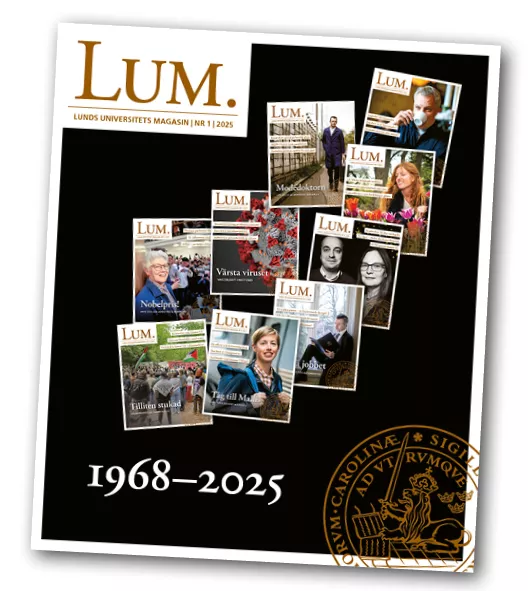If Stig Steen had followed his childhood dream, he would have become a speed skater. But the dream of following in the footsteps of Norwegian speed skater Knut “Kupper'n” Johannesen, who won Olympic gold in Squaw Valley in 1960, resulted in large bony growths on his heels. Stig Steen was forced to hang up his ice skates and instead became a thoracic surgeon and researcher in physiology and medical technology, with inventions such as the LUCAS chest compression device and the Heart-in-a-Box cardiac transport system on his CV. Yet he is not entirely comfortable in the role of researcher.
“I don't fit into the world of academia. In the beginning, when I came to Lund in 1980 as a general surgery specialist, they hounded me in the surgical unit for not doing enough research.”
It did the trick. He completed his thesis in 1984 and to date has contributed to 170 research articles. He then moved to thoracic surgery, where he stayed.
The Pope visited
We meet in Igelösa, north of Lund, where Stig Steen conducts much of his research. Experts from all over the world come here to learn more about transplant surgery in general and the Heart-in-a-Box in particular. And this is where the Pope stayed when he visited Lund a few years ago.
But let’s start with the heart device. LUCAS stands for Lund University Cardiopulmonary Assist System and is attached to the chest. It can both compress the chest and decompress it back to its original position.
“The idea came from a Norwegian who was inspired by a vacuum sewer cleaner. When no one believed in him, he contacted me.”
55,000 LUCAS devices in the world
Stig Steen and his team advanced the idea and, thanks to a resourceful nurse, the device was tested on a patient who had received CPR for 50 minutes. The doctors had given up. After a few minutes in the LUCAS device, they managed to resuscitate the patient. Today, there are 55,000 LUCAS devices around the world and every minute they are used on a person in cardiac arrest.
Stig Steen works in the twilight zone between life and death. When he joined the thorax clinic in Lund in 1985, he was asked to set up a model for heart and lung transplants. There is a severe shortage of organs and the heart must be transplanted within four hours of the donor being pronounced dead in a patient who is probably somewhere else entirely. All in all, a logistical nightmare.
In preclinical studies, the Heart-in-a-Box pioneered by Stig Steen and his research team has tripled the amount of time in which the transplant must be performed. In Australia, Professor David McGiffin, working with Stig Steen, has been studying the heart’s condition after a longer period than that has passed.
“They performed 29 transplants where the heart was preserved in the box for up to nine hours – without complications.”
A cocktail of seven hormones
The secret is a cocktail of seven hormones and it took a while to hone the recipe. A major challenge was how to prevent the nerves still in the heart from absorbing the hormones, which is what we want to avoid.
“Despite many attempts, we couldn’t make it work. But then I woke up one night in 2010 and realised that you could use a small amount of cocaine to prevent the nerves from absorbing the substances in the solution,” says Stig Steen.
It worked. Studies show that a heart that is oxygenated in the box can even recover.
Today, Stig Steen is most enthusiastic about a method he and Professor Johan Nilsson are now developing to check the functions of the donor’s heart. The aim is to be able to evaluate hearts from older donors as well, in the hope of finding more that are strong enough.
Working close to death challenges an egocentric attitude.
“It’s not possible to be self-centred around a young person who is about to die. In those moments, you forget yourself, but you can also find yourself.”
Left as a changed man
Then there was the matter of the nuns and the journey that Stig Steen says saved his life.
“One summer I went to Zaire as the country was called at the time and made the discovery of a lifetime there. I met completely selfless nuns in the jungle who cared for sick people and pregnant women. I came there as an atheist Marxist but left as a changed man.”
He went back to the nuns on two occasions. The last time, he was suspected of being a spy, accused of planning a revolution and imprisoned. He was banned from entering Zaire and decided to invest in the clinic.
“My driving force then became giving hope to those who had none.”
He says that if you are going to work as hard as today’s researchers do, you need to have a spark. He has got his from the patients he meets.
“They have made me not want to give up. As many innovative people say: it’s 99 per cent perspiration, 1 per cent inspiration. And you know, creativity comes when you have no ambitions of your own. If you think about recognition, it disappears.”
What do people ask when they hear what you do for a living?
“I’m not a people person. I don’t tell others what I do. But since you're from Lund University Magazine, I couldn’t say no to you.”






